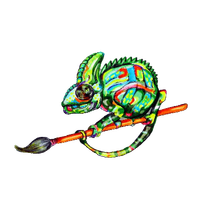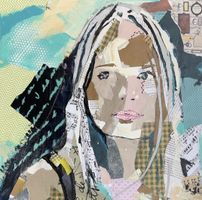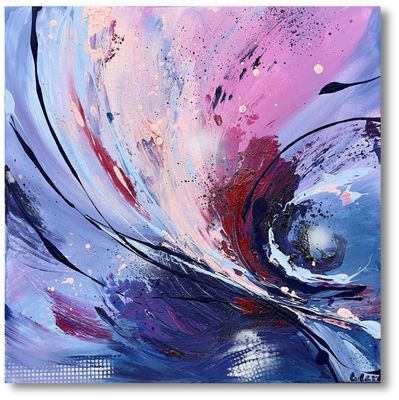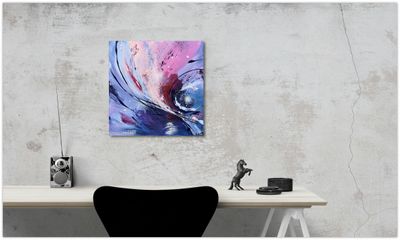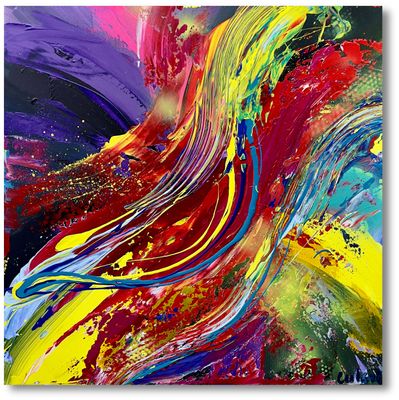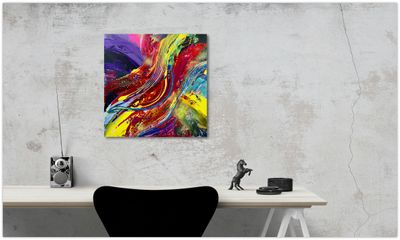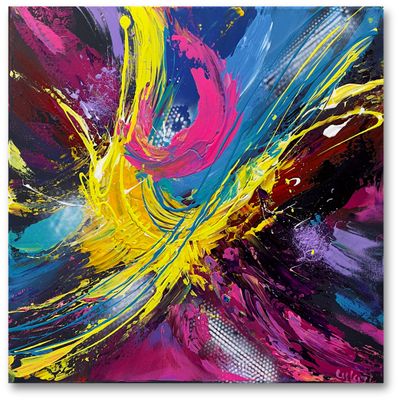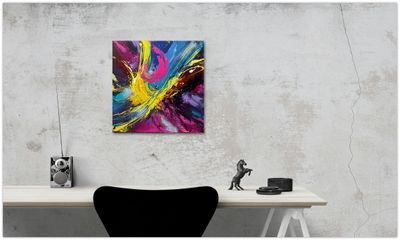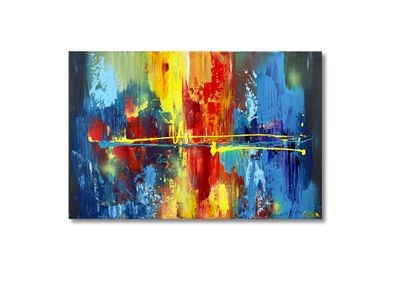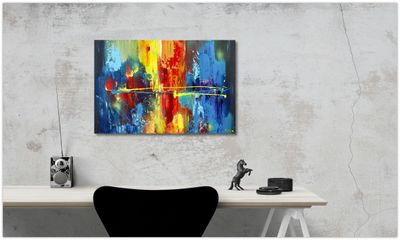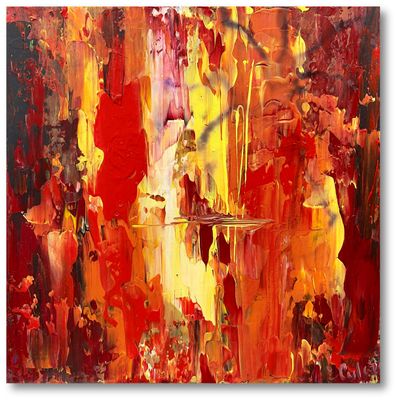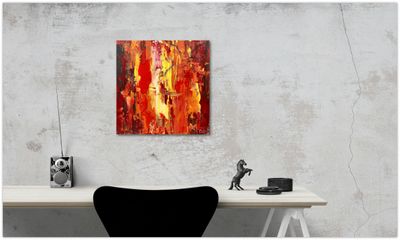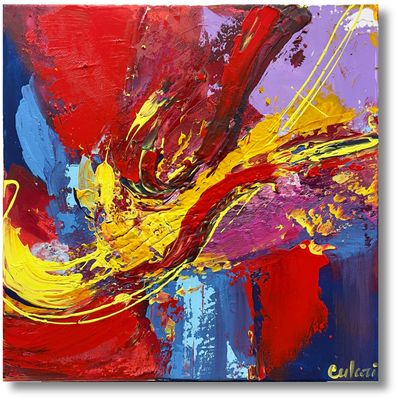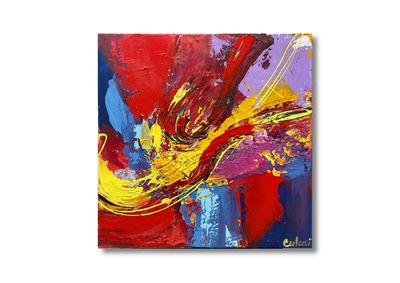Studio Diary
Welcome to my studio diary!
Here, I share thoughts, impressions, and stories about my art.
Whether inspiration from nature, the creation process of a painting, or moments of doubt—every artwork has its own journey.
Glad to have you here!
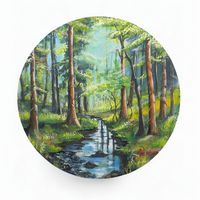
A Window to Nature – Two New Round-Shaped Works
Sure! Here's the English translation of your text:
In a world that is spinning faster and faster, many people seek moments of calm — places where they can take a deep breath and gather new strength. This is exactly the feeling I want to capture with my latest round paintings.
“Forest Spring” – Where the Light Kisses the Stream
The first work shows a clear forest stream winding through tall, slender trees. Sunbeams break through the canopy and dance on the water. The gaze is drawn deep into the forest, into a peaceful, green world. For me, this painting represents retreat, silence, and renewed energy — like a walk in the early morning when everything is still asleep.
“Summer Path” – The Way into the Light
The second painting is full of warmth and lightness. A small path leads through blooming meadows, past wildflowers, into an open, sunny landscape. On the horizon lies a village nestled among green hills. This picture tells of freedom, childhood memories, and the longing for a summer that never ends.
Round Shape – Round Thoughts
Both works are painted on round canvases — not just an aesthetic choice, but also a symbol: The round shape stands for wholeness, for a view into a protected space where nature, light, and silence come into harmony. They invite you to pause and immerse yourself for a moment in another world.
Whether in the living room, the workspace, or a quiet corner for meditation — these paintings create a place of inner peace.
If you have more texts, just send them over!
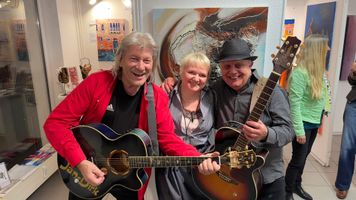
Invitation to the exhibition opening
Hier ist die englische Übersetzung deiner Einladung:
Invitation to the Vernissage
by Larissa Chupakhina
Dear Friends of Art,
When colors tell stories,
when shapes begin to whisper,
and silence starts to resonate through images –
a space opens for that
which words often cannot reach.
I warmly invite you
to join me in celebrating the magic of contemporary art –
at the exhibition
“Contemporary Visual Artists Present Themselves”
Vernissage:
Friday, May 23, 2025, at 7:30 PM
Galerie Kleiner Prinz, Rheinstraße 191, Baden-Baden
Exhibition:
May 23 – June 11, 2025
Opening hours:
Monday to Friday: 3–6 PM
Saturday: 11 AM–1 PM
The evening will be accompanied by the music
of troubadour Jan Dirk and his guitar.
I would be delighted to welcome you on this special evening
and to share my artworks with you.
With heartfelt and artful regards,
Larissa Chupakhina
Wenn du magst, kann ich dir auch eine schlichtere oder förmlichere Variante anbieten.
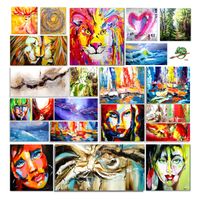
Art Exhibition at the Turmbergstadion Restaurant!
Hier ist die englische Übersetzung deines Textes:
🎨 Starting Today: Art Exhibition at the Turmbergstadion Restaurant!
I'm excited to share that starting today, April 20, 2025, 44 of my artworks are on display at the cozy Turmbergstadion Restaurant in Karlsruhe-Durlach!
Come by, enjoy delicious food and great company, and discover vibrant, expressive paintings that bring the space to life.
📍 Location: Turmbergstadion Restaurant
Liebensteinstraße 1
76227 Karlsruhe (Durlach)
🕒 Opening Hours:
Monday, Wednesday to Saturday: 5:00 PM – 11:00 PM
Sunday: 11:30 AM – 8:00 PM
Tuesday: Closed
I look forward to your visit and wish you an inspiring time at the restaurant!
Wenn du möchtest, kann ich den Text auch anpassen, z. B. für Social Media oder eine Pressemitteilung.
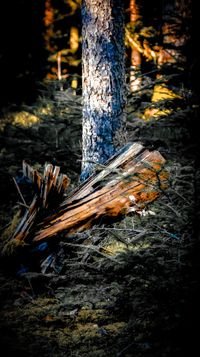
Into the Forest – A Colorful Journey of Inspiration
Neubulach, April 6, 2025
Today, I took a slow walk through the Black Forest—without a destination, just with open eyes and a awake heart. The trees whispered stories, the light danced on the damp ground, and moss in a thousand shades of green reminded me of how many nuances life holds.
Each step was like a brushstroke in the inner picture I carry. I watched the sunlight break through the branches, casting golden highlights while shadows flowed like ink over the path. It is in moments like these that my paintings are born—not in the studio, but outside, where nature speaks.
I took some photos, gathered colors, and jotted down thoughts. Maybe soon a new work will be born from this—who knows?
Thank you for accompanying me on this journey.
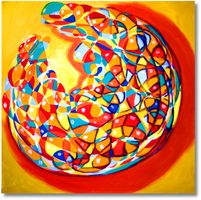
Abstract Art: A Journey into the World of Shapes and Colors
Abstract Art: A Journey into the World of Shapes and Colors
Abstract art is more than just colors and shapes on a canvas—it is a language without words that expresses emotions, thoughts, and energy. Unlike representational art, which depicts real objects or scenes, abstract art breaks free from recognizable reality and invites the viewer to find their own interpretation.
In this blog post, we dive into the fascinating world of abstract art, explore its origins, important artists, and the question: What makes abstract art so special?
What is Abstract Art?
Abstract art forgoes direct representation of the visible world. Instead, it uses colors, shapes, lines, and textures to convey moods, ideas, or pure aesthetics. It can be geometrically strict (like Piet Mondrian) or emotionally charged (like Jackson Pollock).
Characteristics of Abstract Art:
Freedom from representational depictionEmphasis on composition, color, and formSubjective interpretation by the viewerExperimental techniques
The History of Abstract Art
The roots of abstraction date back to the 19th century, but as an independent movement, it emerged in the early 20th century.
Key Milestones:
Wassily Kandinsky
is considered a pioneer of abstract painting with his work
“The First Abstract Watercolor”
(1910).
Piet Mondrian
developed
Neoplasticism
with its strict geometric forms.
Jackson Pollock
revolutionized art with his
Action Painting
and drip technique.
Mark Rothko
created emotional color field paintings that immerse the viewer in meditative states.
Why Abstract Art is Fascinating
Everyone sees something different
— Since there is no fixed meaning, interpretation becomes a personal experience.
Pure emotion
— Abstract works often affect the emotional level directly, without detours through recognizable motifs.
Freedom of expression
— Artists can work completely free from rules.
Modern interior design
— Abstract images are timeless and fit into almost any space.
Experiencing Abstract Art Yourself
Would you like to not only look at abstract art but also try it yourself? Here are a few tips:
Experiment with acrylic paint and various tools (brushes, palette knives, even your hands!).Play with contrasts — hard vs. soft, textured vs. flowing.Let music inspire you — paint what you feel while listening to your favorite song.
Conclusion
Abstract art is an invitation to see the world with new eyes. It challenges us to discover our own thoughts and feelings in shapes and colors. Whether as a viewer or as an artist, there is infinite freedom in abstraction.
What does abstract art mean to you? Share your thoughts in the comments!
This post was written by Larissa Chupakhina. Follow us for more art inspiration!
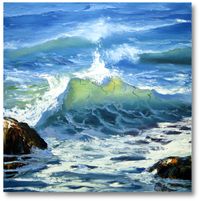
Oil Painting: Capturing the Fascination of the Sea on Canvas
Hier ist die englische Übersetzung deines Blogbeitrags zur Ölmalerei des Meeres:
Oil Painting: Capturing the Fascination of the Sea on Canvas
Introduction
The sea — an endless source of inspiration! Its powerful waves, the gentle play of light on the water’s surface, and the vastness of the horizon have fascinated artists for centuries. In oil painting, the magic of the sea can be captured particularly impressively thanks to the vibrant colors and versatile techniques that oil paints allow.
In this blog post, we dive into the world of maritime oil painting, explore famous seascapes, practical tips, and the question: How do you paint realistic or expressive sea motifs with oil paint?
Why Paint the Sea in Oil?
Oil paint is ideal for seascapes because it offers:
Deep, vibrant colors
Long drying times
, which make smooth transitions (e.g., in waves) easier
Textures
that come alive through impasto application or glazing techniques
Famous Artists and Their Seascapes
Ivan Aivazovsky
— The Russian painter created dramatic seascapes with perfectly captured light reflections.
Winslow Homer
— His powerful wave depictions show the primal force of the ocean.
Claude Monet
— Impressionistic views of the sea with vibrant play of colors.
How to Paint the Sea in Oil — Step by Step
Preparation: Materials & Inspiration
Ground:
A toned canvas (e.g., with a light blue or gray underpainting) helps set the mood.
Color palette:
Blue-green tones (Phthalo Blue, Prussian Blue, Emerald Green)White (Titanium White for light reflections)Earth tones (Umbra, Ochre for sand or rocks)
The Sky — Setting the Mood
Start with the horizon and sky, as they determine the light source for the water. Use soft transitions for calm moods or dramatic clouds for stormy scenes.
The Water — Movement and Depth
Wave structure:
Work from dark to light tones—the base of the wave is darker, the crest lighter.
Light reflections:
Add small highlights with Titanium White or Lemon Yellow.
Foam & spray:
Use a dry brush or palette knife to create splashes and blurs.
Details: Beach, Rocks & Ships
Rocks & coastline:
Use textured brush strokes or palette knives for rough surfaces.
Ships & boats:
They add scale and narrative depth to the painting.
Tips for Realistic & Expressive Seascapes
✅ Observe the sea live or use reference photos—waves follow specific patterns.
✅ Experiment with brushes and palette knives—impasto adds dynamism, glazes create depth.
✅ Play with perspective—close-ups of waves look powerful, wide horizons convey calmness.
✅ Use various shades of blue—the sea is never just one color!
Conclusion: Your Sea on Canvas
Oil painting offers endless possibilities to capture the beauty and power of the sea. Whether you paint realistic surf waves or expressive color fields for a modern interpretation—each painting becomes unique.
Give it a try! Start with a small canvas and let yourself be inspired by the movement of the water.
Did you enjoy this post? Share your own seascapes or questions in the comments! 🌊🎨
This post was written by Larissa Chupakhina. Follow us for more art inspiration and painting techniques!
Tip: If you’re a beginner, try acrylic paints first as a faster alternative—the techniques are similar!
Möchtest du noch eine Version, die noch etwas lockerer oder noch formeller klingt?
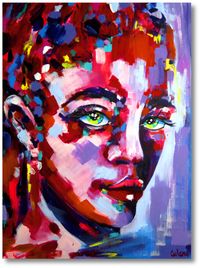
Portrait Painting: A Journey Through Faces and Emotions
Portrait Painting: A Journey Through Faces and Emotions
Since ancient times, humans have been fascinated by the human face — as a mirror of the soul, a testament to time, and an artistic challenge. Portrait painting has a history spanning millennia, from Egyptian mummy portraits through Renaissance masters to modern, abstract interpretations.
In this post, we explore the development of portrait art, its significance, and techniques. At the end, I invite you to discover some of my own portrait works — maybe one or the other will inspire you!
The History of Portrait Painting
Antiquity & Middle Ages: Symbols Instead of Individuality
Egypt:
Idealized appearance for eternity (mummy portraits).
Roman Emperor Portraits:
Realistic depiction of power and dignity.
Middle Ages:
Stylized, often religiously influenced faces (e.g., saints’ images).
Renaissance: The Human Being at the Center
Leonardo da Vinci
(
Mona Lisa
) perfected expression and perspective.
Albrecht Dürer
created detailed self-portraits as a sign of artistic self-awareness.
Modern & Abstraction: From Likeness to Feeling
Vincent van Gogh
painted himself with expressive brushstrokes.
Pablo Picasso
deconstructed faces into cubist forms.
Modern Photorealism:
Almost photographic precision (e.g., Chuck Close).
What Makes a Good Portrait?
A successful portrait shows more than just resemblance — it conveys personality, mood, and story.
Technical Elements:
✔ Proportions (correct placement of eyes, nose, mouth)
✔ Light & shadow (create drama or softness)
✔ Background (supports the message of the portrait)
Emotional Impact:
Eye direction: eyes as the central anchor point.Brushwork: fine details or rough strokes change the message.
My Portrait Works – An Invitation to Explore
In my artistic work, I experiment with different styles — from realistic studies to expressive, colorful interpretations.
Some examples of my portraits:
Classical Oil Painting:
Detailed faces with subtle light effects.
Abstract Approaches:
Emotions through color fields and strong contours.
Mixed Media Experiments:
Collages combining drawing and texture.
I warmly invite you to visit my gallery:
🔗 [Link to my website]
Try Portrait Painting Yourself – Tips for Beginners
Start with sketches — practice facial features with pencil or charcoal.Use references — photos or live models help with proportions.Experiment with styles — realistic, cartoonish, or abstract? Find your voice!
Conclusion: Faces Tell Stories
Whether as a historical document or a modern artwork, portraits remain one of the most intimate and expressive forms of painting. I hope this post inspires you to pick up the brush yourself or rediscover the depth of human faces.
Feel free to visit my works and let’s discuss your favorite portraits in the comments! 👩🎨
#PortraitPainting #ArtHistory #ArtistInsights #PaintingPeople
This post was written by Larissa Chupakhina. Follow me for more art & creative processes!
P.S.: Would you like to commission a personal portrait? Write to me! 🖌️

